13-21 MARCH 2025
By Luis Gles
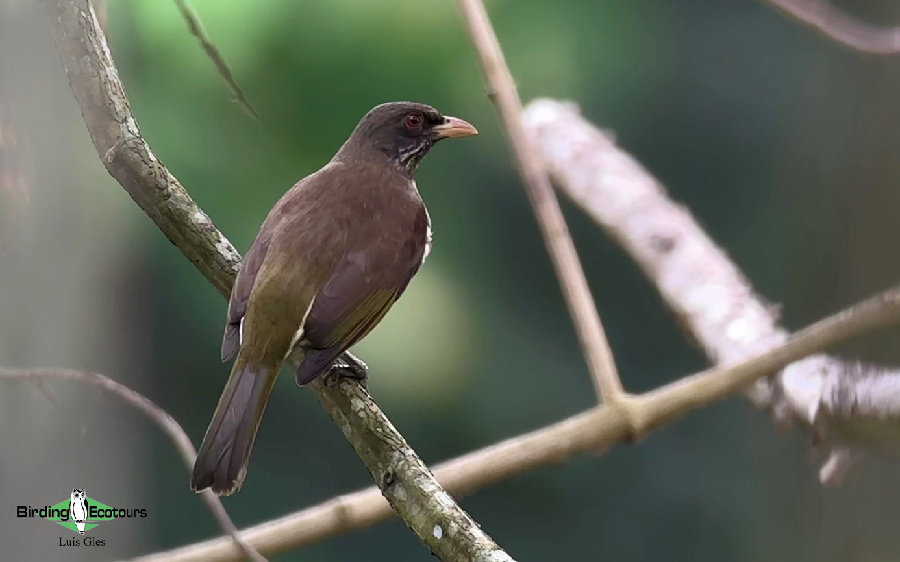
Palmchat, the national bird of the Dominican Republic.
Overview
This scheduled group tour turned into a private journey for our beloved Australian guests, Davie and Barbara. The adventure began in Santo Domingo, the capital of the Dominican Republic, on 13 March 2025 and concluded there on 21 March 2025. The itinerary was designed to highlight the island’s premier birding destinations, including the National Botanical Garden, Los Haitises National Park, Barahona, Cachote, Sierra de Bahoruco, Cabo Rojo, and Bahía de las Águilas – where Davie was thrilled to encounter the endemic Lemaire’s Turk’s Cap Cactus to enrich his cactus list.
Throughout our time in the Dominican Republic, we had unforgettable encounters with all the island’s endemics and many endangered bird species, such as Palmchat, the national bird, the Critically Endangered (BirdLife International) Ridgway’s Hawk, the declining Golden Swallow, Rufous-throated Solitaire, Ashy-faced Owl, White-fronted Quail-Dove, Bay-breasted Cuckoo, Hispaniolan Trogon, Broad-billed and Narrow-billed Tody, Antillean Piculet, Hispaniolan Amazon, Hispaniolan Parakeet, Flat-billed Vireo, the always shy La Selle Thrush, Hispaniolan Crossbill, Antillean Euphonia, Western and Eastern Chat-Tanager, Green-tailed and White-winged Warbler, along with Hispaniolan Spindalis and Hispaniolan Oriole, for a total species list of 135, of which three were heard only and not seen. The full bird species list is at the end of this report.
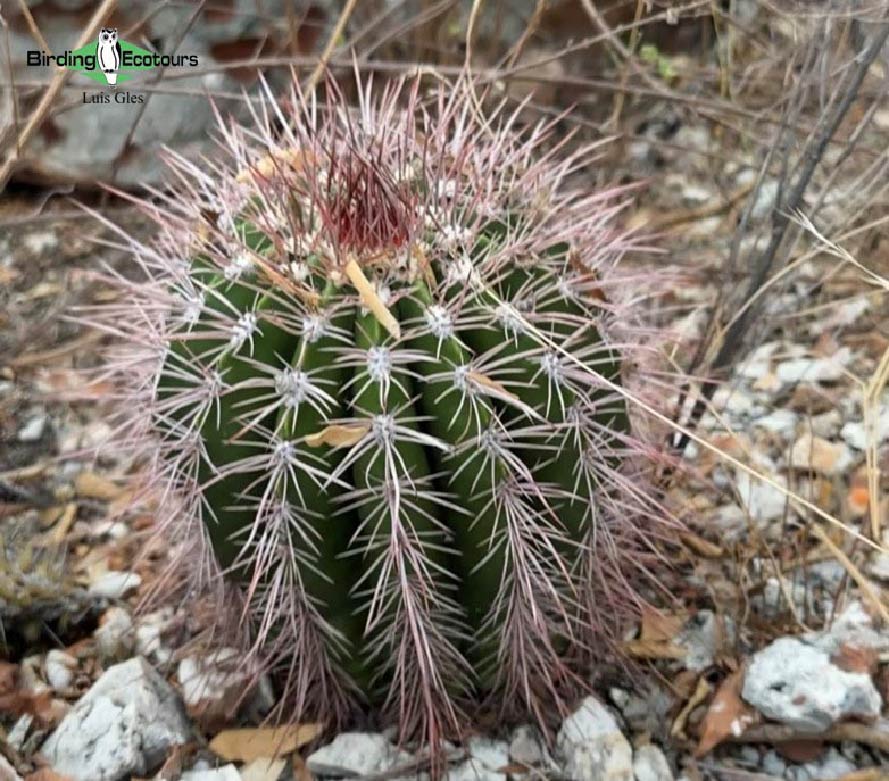
Lemaire’s Turk’s Cap Cactus.
Detailed Report
Day 1, 13th March 2025. Santo Domingo
After arriving in the folkloric Santo Domingo, the capital of the Dominican Republic, we met in the lobby of our hotel in the old colonial district (Zona Colonial). We decided to enjoy a short walk in the colonial district to a restaurant for dinner at Plaza Colon. Over our meal, we reviewed the trip itinerary, birding targets, and logistics for the days ahead. Spirits were high and the excitement for the adventure was noticeable.
Day 2, 14th March 2025. Birding the National Botanical Garden and transfer to Sabana de La Mar
Departing early from our hotel after a delicious typical Dominican breakfast, we headed to the National Botanical Gardens for our first birding of the tour. Before getting inside the place, we spotted our first groups of Palmchat and Antillean Palm Swift, followed by a noisy group of Hispaniolan Parakeets. Hispaniolan Woodpeckers were also present in good numbers. Hispaniolan Mango and the gorgeous Vervain Hummingbird, the second-smallest bird in the world, were some of the birds we had in the first 30 minutes of birding. As we continued walking through the park, we added more birds like Common Ground Dove, Mourning Dove, and Hispaniolan Lizard Cuckoo,which gave us great views. In the far section of the gardens, we found one of the main targets for the morning, West Indian Whistling Duck.
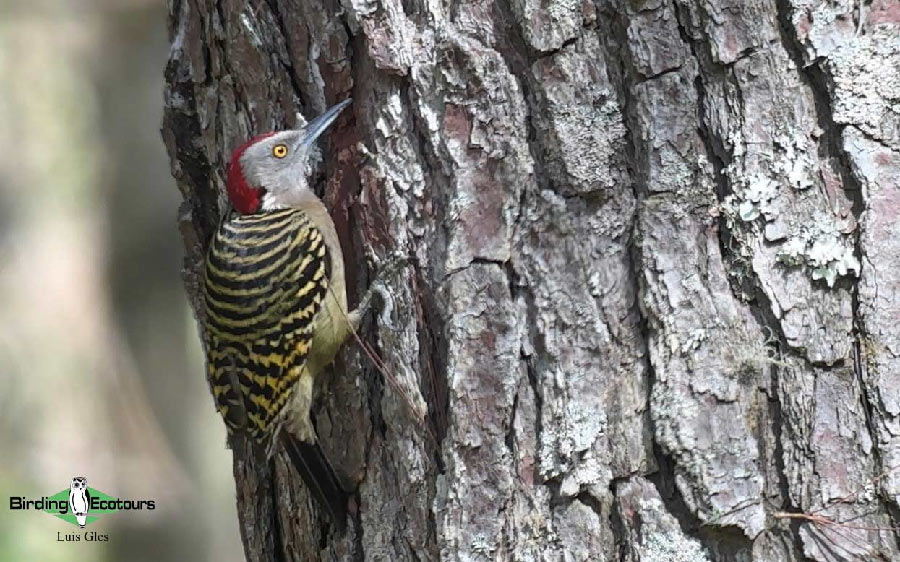
Hispaniolan Woodpecker was seen at several locations on this tour.
After a good morning of birding as our introduction to the country, we started our journey to Sabana de la Mar in the northeast of the island, to spend the night in comfortable accommodation in town. Along the road, we stopped for lunch in a popular restaurant, with an Antillean Palm Swift colony in the roof. The drive took almost all afternoon, and by the time we arrived at Sabana de la Mar it was almost sunset, so we checked in, had dinner, checked the bird list, and rested for the night.
Day 3, 15th March 2025. Birding Los Haitises National Park and transfer to Santo Domingo
Following a great, early, breakfast we met up with Juan, who has been working with with Peregrine Foundation for the past 35 years and remains involved in everything related to Ridgway’s Hawk. We drove for over 30 minutes to the entrance of the Los Haitises National Park, where we started hiking with Juan, who took us to an opening inside the national park, where we waited for more than 45 minutes. Juan started walking uphill inside the forest, and told us to be aware. In the meantime, Plain Pigeon, Stolid Flycatcher, and the vocal White-necked Crow were our entertainment, until a beautiful Ridgway’s Hawk decided to rise up to the sky and started soaring in a mixed flock of Turkey Vultures, followed by a Peregrine Falcon that crossed the sky. In the distance, we heard Juan whistling and screaming in Spanish “EL GAVILAN! EL GAVILAN!” (meaning “Hawk! Hawk!”) What an exciting moment! We enjoyed this endangered species for a couple of minutes, before it flew over the hill and we lost sight of it. Los Haitises National Park is the stronghold of this endangered raptor, where it is safe thanks to the hard work of the Peregrine Foundation in the Dominican Republic.
We continued birding around the park and connected with more birds, like the adorable Broad-billed Tody, Hispaniolan Mango, Greater Antillean Bullfinch, Vervain Hummingbird, Hispaniolan Woodpecker, Antillean Piculet, Black-whiskered Vireo, Palmchat, Black-crowned Palm-tanager, Greater Antillean Grackle, and Mangrove Cuckoo. A few North American warblers were present, including Northern and Louisiana Waterthrushes, and Northern Parula. Western Cattle Egret, Great Egret, and Limpkin were also in the pastures of the park. We finished birding Los Haitises National Park and, on the way to town for lunch at the hotel, we enjoyed some shorebirds and terns at the pier of Sabana de la Mar. After a delicious lunch, we drove back to the colonial zone of Santo Domingo for dinner and another night in the heart of the city.
Day 4, 16th March 2025. Birding las Salinas on our way to Pedernales
After an early breakfast, we left Santo Domingo and started the longest drive of the tour, to the south of the island. En route, we stopped in Salinas Bani, a popular birding spot, where we had views of the Caribbean subspecies of Clapper Rail and American Yellow Warbler singing. The diversity of shorebirds was great, we had Grey Plover, Killdeer, Semipalmated Plover, Spotted Sandpiper, Lesser Yellowlegs, Ruddy Turnstone, Sanderling, Least and Semipalmated Sandpiper, stunning Snowy Plover and Stilt Sandpiper (Davie’s favorite bird for that morning), along with a group of White-cheeked Pintails, and five American Flamingos spotted by our driver, David, while we were leaving the park.
We travelled south and stopped for food, birding along the way, adding birds like Smooth-billed Ani, Red-tailed Hawk, Grey Kingbird, Northern Mockingbird, Magnificent Frigatebird, Osprey, Laughing Gull, and the introduced Village Weaver. We arrived at Pedernales, a city on the southern border with Haiti, right in time for dinner. We checked the bird list for the day and then rested for the night.
Day 5, 17th March 2025. Birding the Alcoa Road and Cabo Rojo
Another early start and, with a packed breakfast, we departed our hotel at 5 am in the direction of the southern slope of Sierra de Bahoruco. In this area, we encountered two Hispaniolan Nightjars before sunrise, along with the distant calls of Stygian Owl. We continued ascending the mountains to La Charca, a great birding spot, where we watched a show between a group of Hispaniolan Palm Crows and a young Merlin interacting with each other. While observing these birds, a Golden Swallow flew in and circled above the trail, giving really good views.Walking down the trail we found more birds, including the flashy Red-legged Thrush, Rufous-throated Solitaire, Greater Antillean Elaenia, Hispaniolan Pewee, Hispaniolan Amazon, Hispaniolan Parakeet, Hispaniolan Emerald, Hispaniolan Mango, Scaly-naped Pigeon, Red-tailed Hawk, and Antillean Palm Swift. North American migrants were also present, including Yellow-rumped Warbler, Prairie Warbler, Palm Warbler, American Redstart, and Northern Parula. It was a great morning, but we were still missing the Endangered (BirdLife International) Hispaniolan Crossbill.
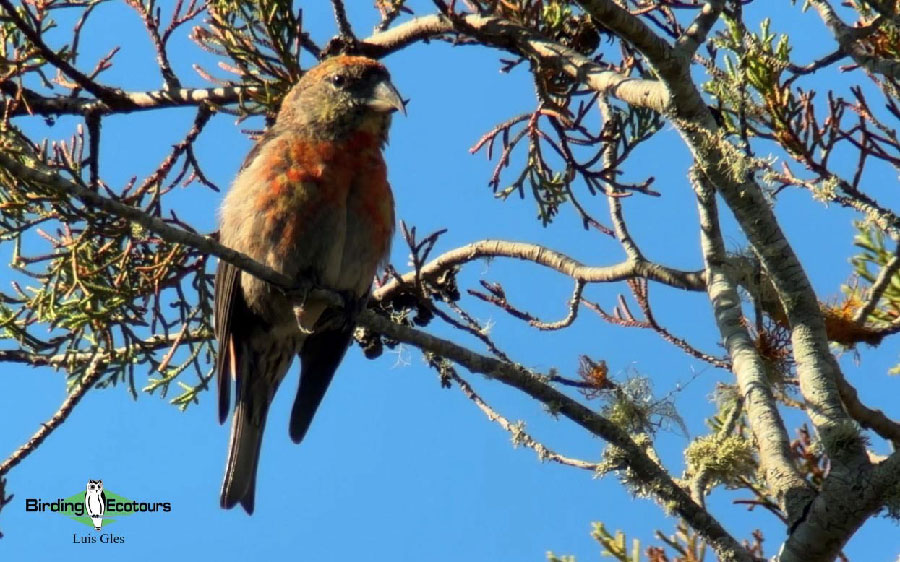
Hispaniolan Crossbill was seen at Sierra de Bahoruco.
Miraculously, we noticed a small passerine drop into a dry pine tree and, to my surprise, the small passerine was an Antillean Siskin that had landed right next to a preening Hispaniolan Crossbill! This allowed us to get closer for immaculate scope views of this elusive finch, and one of our main targets for the tour. Elated with the victory of seeing the crossbill, as well as other Hispaniolan endemics and some regional specialties, we began descending the mountain.
As we descended, we spotted a beautiful Catesby’s Pointed Snake, a species of snake endemic to the island. While trying to get better views of the snake, a Greater Antillean Bullfinch started calling nearby. We abandoned the snake and tracked the call until we saw a male with a female sitting nearby. The stop also produced great views of Antillean Piculet, a perfect visual appetizer to prepare us for lunch!
We ate lunch at the Bahia de las Aguilas and, after a delicious meal, we enjoyed some birding along the coast. With the help of our driver, we found the Lemaire’s Turk’s Cap Cactus, a cactus species high on Davie’s list. After this great encounter, we inspected the cliffs from closer and were lucky to see White-tailed Tropicbirds flying over the ocean and interacting with Magnificent Frigatebirds.
We continued towards our next lodge, and at Cabo Rojo, we checked the wetlands along the road and added some waders to our trip list, including two Lesser Yellowlegs, one Short-billed Dowitcher, over a dozen Least Sandpipers, and a large flock of Stilt Sandpipers. There were American White Ibis, Tricolored Heron, and Reddish Egret foraging. A Northern Shoveler, with two White-cheeked Pintails, was hiding in some grass.
Just over an hour later, we arrived at El Quemaito, our lodge for the night, where we had dinner.
Day 6, 18th March 2025. Birding Cachote and transfer to Duvergel
We left the hotel very early, way before sunrise, with a packed breakfast. Ascending to Cachote, another well-known area in the Sierra De Bahoruco, this area is known for its moister forest and a great diversity of plants. Our first target of the day was Ashy-faced Owl, which we tried for multiple times without success until, just before sunrise, a pair of owls responded to the playback but did not show up for a visual. We continued our drive to the top of Cachote, where the park ranger Ramon was waiting for us. Ramon has worked in this region for a long time, helping with the conservation of the area and the birds that live here. During his time here, Ramon has been able to attract White-fronted Quail-Dove – an incredibly elusive bird that is known to be one of the hardest birds to find in the Dominican Republic and the whole of the Caribbean – to a feeder. At the feeder, we were lucky to see a Ruddy Quail-Dove, giving great views of this difficult bird. While we enjoyed the quail-dove, an Eastern Chat-Tanager began calling a little behind us. The birds crossed the trail and continued foraging close to us, allowing a great study of another shy and endemic bird. Apart from the feeder area, we enjoyed good views of the resident Sharp-shinned and Red-tailed Hawks. We also encountered the second tody species that calls Hispaniola home, the Narrow-billed Tody, which was at first difficult to see well, but we then had great views.
Hispaniolan Pewee, Rufous-throated Solitaire, and Hispaniolan Spindalis were seen along the trail, as well as North American migrants, including Yellow-rumped Warbler and Black-throated Green Warbler. Without a doubt, the bird of the morning was the Hispaniolan Euphonia, which showed up after Ramon pointed out the tree that it likes. In the same tree, we saw Black-whiskered Vireo, Plain Pigeon, and Hispaniolan Emerald, which we also saw well where we had parked the car.
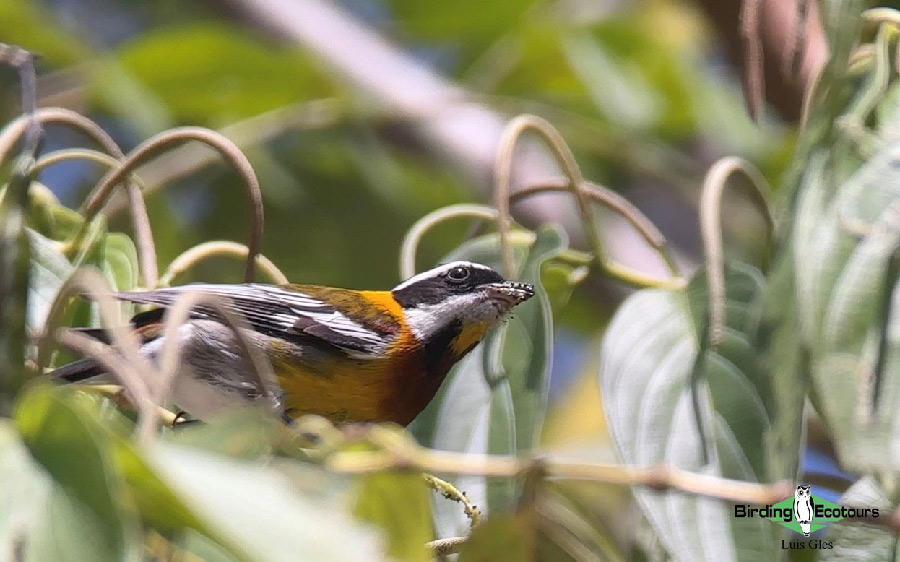
We enjoyed excellent views of the attractive Hispaniolan Spindalis.
We departed for Barahona for lunch, eating popular sandwiches in this busy city, which used to be the capital city of the Dominican Republic. At lunch, we were joined by our local guide, Efrain, who was to be our driver. After lunch, we said goodbye to David and continued our tour with Efrain, who stayed with us for the rest of the trip. We set off to the small town of Duverge, close to the border with Haiti, but this time on the northern side of the Sierra de Bahoruco, where we were to spend two nights. We checked in at the lodge and headed for a little birding before dinner.
Birding the Puerto Escondido area, including the well-known Rabo de Gato trail, we had some trouble finding Flat-billed Vireo. We eventually had great views, sitting for about ten seconds in the open – a lot for this bird, which usually hides deep in dense bushes. We had a large flock of Antillean Siskins bouncing in the agricultural fields. Hispaniolan Amazons and White-necked Crows were present in good numbers, and the noise of Hispaniolan Woodpeckers was all over. The afternoon birding had been great, and night was approaching, but we didn’t want to stop birding until we got the oriole. Hurrying against the darkness, and while tracking a Green-tailed Warbler, we stumbled onto a really cooperative pair of Hispaniolan Orioles, giving extreme happiness. We enjoyed the bird for some time before heading back to town for dinner and to prepare for our big day going to Zapotén!
Day 7, 19th March 2025. Birding Zapotén and Rabo De Gato
We started at 3:45 am, and drove to Puerto Escondido, where we met Rafael, the most experienced local guide in this montane range and our driver for the day. We started driving to the top, to arrive at the Zapotén area in the Sierra de Bahoruco before sunrise. The drive up the mountain was incredibly rough – this road is in a dry river bed that flows only during the rainy season. While driving up, we stopped to investigate an area where an Ashy-faced Owl was reported a few days ago. As soon as we stopped, we heard screech calls and looked for the owl, which turned out to be an American Barn Owl. We continued up for another 45 minutes, parked the car, ate breakfast, and then started our best birding day of the tour. We began by looking for our main and hardest target, the La Selle Thrush.We heard it multiple times before Rafael finally spotted an individual perching, exposing itself while singing. We enjoyed great views, followed by the beautiful song of Rufous-throated Solitaire,which also provided good views.Then we saw our first White-winged Warbler of the tour! The morning got even better when a mixed flock with Pine Warblers, Green-tailed Warblers, and a Hispaniolan Spindalis passed by. While happily enjoying this good set of birds, a male Hispaniolan Trogon interrupted, followed by its mate, truly jaw-dropping! The list of birds we had before noon was amazing, with Hispaniolan Pewee, Greater Antillean Elaenia, Narrow-billed Tody, the elusive Western Chat-Tanager, Golden Swallow, Red-legged Thrush, Antillean Siskin, Black-crowned Palm-tanager, Bananaquit, Greater Antillean Bullfinch, and Narrow-billed Tody, which was quite common in the high elevation. It was a good morning, but we still had to find one of the most elusive birds in the whole of the Caribbean, the Endangered (BirdLife International) Bay-breasted Cuckoo. We started descending, in search of the cuckoo.
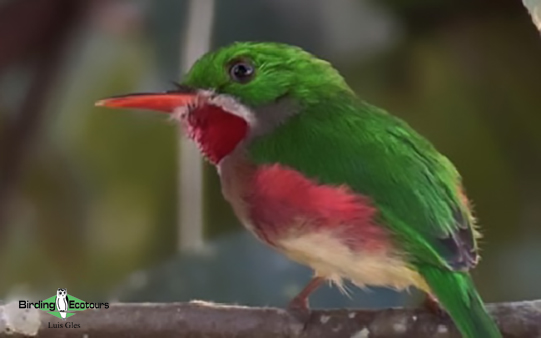
Broad-billed Tody was one of two tody species seen on this tour.
Migratory birds were also present in Zapotén, with American Redstart, Cape May Warbler, Black-throated Blue Warbler, Northern Parula, Black-and-white Warbler, and Ovenbird and Palm Warbler. On the way down, we enjoyed views of Loggerhead Kingbird and many Stolid Flycatchers and Grey Kingbirds, but no cuckoo.We were thinking that our luck had run out, when Efrain, who was ahead of the group, spotted a Bay-breasted Cuckoo sitting quietly. It didn’t give us good views, but we were nevertheless satisfied, given the effort we had put into it.
We returned to our lodge to rest in the afternoon, in preparation for some evening adventures. After a good rest, we headed up to Puerto Escondido in search of Least Poorwill. We arrived at the known location where Efrain always has luck with this bird. While waiting, flocks of Hispaniolan Parakeets started flying over us in the direction of the top of the hills. Scaly-naped Pigeons and Plain Pigeons were also looking for roosts. Key West Quail-Dove started singing, so I decided to track the call when, to our surprise, a Bay-breasted Cuckoo showed up. We all enjoyed much better views than what we had experienced earlier! Very happy, we all sat down patiently until darkness arrived, and with it the song of Least Poorwill, but unfortunately, we couldn’t see it. We departed for dinner, with a heard-only experience of this crepuscular creature, and went to bed.
Day 8, 20th March 2025. Duverge to Santo Domingo
We had an easy morning, visiting a restaurant in town for a great Dominican breakfast, before heading out to Lake Enriquillo, the largest lake in the Dominican Republic (and the entire Caribbean). It is in the southwestern region of the country and is on the border with Haiti. Lake Enriquillo is known for its high salt levels and provides good habitat for migratory birds, and is also the best place to see the endemic Hispaniolan Ground Iguana. We checked the west shoreline, which added some birds to our list, such as Lesser and Greater Yellowlegs, Killdeer, Grey Plover, Semipalmated Plover, Least Sandpiper, Caspian Tern, and Burrowing Owl. It holds a good population of Caribbean Martins and Hispaniolan Palm Crows, and other birds seen here included Common Ground Dove, Zenaida Dove, White-winged Dove, Smooth-billed Ani, Grey Kingbird, Stolid Flycatcher, Black-whiskered Vireo, and Black-crowned Palm-tanager. After enjoying the birding along the lake, and the views of the iguana, we departed for Barahona, where we stopped for lunch at the best sandwich spot on the island – we had to have seconds of these!
We rushed our lunch because we had four hours of driving ahead of us, but before leaving Barahona, we decided to check the harbor for a two-month-old record of a Sabine’s Gull, the first ever seen on the island. To our surprise, the bird was still present along with a Ring-billed Gull, both of them lifers for our local guide Efrain. We enjoyed the bird for some time before starting our long journey back to Santo Domingo. We had dinner in the colonial zone after checking into our hotel for our last night in the Dominican Republic.
Day 9, 21st March 2025. Departure from Santo Domingo
Our final morning was relaxing, and we prepared for the flight to Florida, USA, with a delicious breakfast in our hotel and the sounds of Hispaniolan Parakeets. This was the end of a great tour, with Barbara and Davie finding not only all the endemic birds of the Dominican Republic, but also enjoying the natural history of this enchanting island, from the beauty of its Melocactus to the unique lizards and landscapes. We truly enjoyed this successful Birding Ecotours tour in the Dominican Republic.
Bird List – Following IOC
Birds ‘heard only’ are marked with (H) after the common name, all other species were seen.
The following notation after species names is used to show conservation status following BirdLife International: CE = Critically Endangered, EN = Endangered, VU = Vulnerable, NT = Near Threatened.
| Common Name | Scientific Name |
| Ducks (Anatidae) | |
| West Indian Whistling Duck – NT | Dendrocygna arborea |
| Northern Shoveler | Spatula clypeata |
| White-cheeked Pintail | Anas bahamensis |
| Flamingos (Phoenicopteridae) | |
| American Flamingo | Phoenicopterus ruber |
| Grebes (Podicipedidae) | |
| Least Grebe | Tachybaptus dominicus |
| Pigeons, Doves (Columbidae) | |
| Rock Dove | Columba livia |
| Scaly-naped Pigeon | Patagioenas squamosa |
| Plain Pigeon – NT | Patagioenas inornata |
| Common Ground Dove | Columbina passaria |
| White-fronted Quail-Dove – EN | Geotrygon leucometopia |
| Key West Quail-Dove | Geotrygon chrysia |
| Ruddy Quail-Dove | Geotrygon montana |
| Eurasian Collared Dove | Streptopelia decaocto |
| White-winged Dove | Zenaida asiatica |
| Zenaida Dove | Zenaida aurita |
| Mourning Dove | Zenaida macroura |
| Anis, Cuckoos (Cuculidae) | |
| Smooth-billed Ani | Crotophaga ani |
| Yellow-billed Cuckoo | Coccyzus americano |
| Bay-breasted Cuckoo – EN | Coccyzus rufigularis |
| Hispaniolan Lizard Cuckoo | Coccyzus longirostris |
| Swifts (Apodidae) | |
| Antillean Palm Swift | Tachornis phoenicobia |
| Hummingbirds (Trochilidae) | |
| Hispaniolan Mango | Anthracothorax dominicus |
| Vervain Hummingbird | Mellisuga minima |
| Hispaniolan Emerald | Chlorostilbon swainsonii |
| Coots, Rails, Crakes (Rallidae) | |
| Common Gallinule | Gallinula galeata |
| Limpkin (Aramidae) | |
| Limpkin | Aramus guarauna |
| Plovers (Charadriidae) | |
| Black-necked Stilt | Himantopus mexicanus |
| Grey Plover – VU | Pluvialis squatarola |
| Killdeer – NT | Charadrius vociferus |
| Semipalmated Plover | Charadrius semipalmatus |
| Snowy Plover – NT | Anarhychus nivosus |
| | |
| Sandpipers and Allies (Scolopacidae) | |
| Short-billed Dowitcher – VU | Limnidromus griseus |
| Least Sandpiper – NT | Calidris minutilla |
| Spotted Sandpiper | Actitis macularius |
| Solitary Sandpiper | Tringa solitaria |
| Greater Yellowlegs – NT | Tringa melanoleuca |
| Lesser Yellowlegs – VU | Tringa flavipes |
| Ruddy Turnstone – NT | Arenaria interpres |
| Stilt Sandpiper – NT | Calidris himantopus |
| Semipalmated Sandpiper – NT | Calidris pusilla |
| Gulls, Terns, Skimmers (Laridae) | |
| Sabine’s Gull | Xema sabini |
| Laughing Gull | Leucophaeus atricilla |
| Caspian Tern | Hydroprogne cassia |
| Royal Tern | Thalasseus maximus |
| Tropicbirds (Phaethontidae) | |
| White-tailed Tropicbird | Phaethon lepturus |
| | |
| Frigatebirds (Fregatidae) | |
| Magnificent Frigatebird | Fregata magnificens |
| Pelicans (Pelecanidae) | |
| Brown Pelican | Pelecanus occidentalis |
| Herons, Egrets (Ardeidae) | |
| Great Egret | Ardea alba |
| Snowy Egret | Egretta thula |
| Little Blue Heron | Egretta caerulea |
| Tricolored Heron | Egretta tricolor |
| Western Cattle Egret | Bubulcus ibis |
| Reddish Egret – NT | Egretta rufescens |
| Green Heron | Butorides virescens |
| Vultures (Cathartidae) | |
| Turkey Vulture | Cathartes aura |
| Hawks, Eagles (Accipitridae) | |
| Osprey | Pandion haliaetus |
| Sharp-shinned Hawk | Accipiter striatus |
| Ridgway’s Hawk – CR | Buteo ridgwayi |
| Red-tailed Hawk | Buteo jamaicensis |
| Barn Owls (Tytonidae) | |
| American Barn Owl | Tyto alba |
| Ashy-faced Owl | Tyto glaucops |
| | |
| Owls (Strigidae) | |
| Burrowing Owl | Athene cunicularia |
| Styian Owl | Asio stygius |
| Nightjars (Campulgidae) | |
| Hispaniolan Nightjar (H) | Antrostomus cubanensis |
| Least Poorwill – NT (H) | Siphonorhis brewsteri |
| Trogons (Trogonidae) | |
| Hispaniolan Trogon | Priotelus roseigaster |
| Todies (Todidae) | |
| Broad-billed Tody | Todus subulatus |
| Narrow-billed Tody | Todus angustirostris |
| Kingfishers (Alcedinidae) | |
| Belted Kingfisher | Megaceryle alcyon |
| Woodpeckers (Picidae) | |
| Antillean Piculet | Nesoctites micromegas |
| Hispaniolan Woodpecker | Melanerpes striatus |
| Caracaras, Falcons (Falconidae) | |
| American Kestrel | Falco sparveriusa |
| Merlin | Falco columbarium |
| Peregrine Falcon | Falco peregrinus |
| Parrots (Psittacidae) | |
| Hispaniolan Amazon – VU | Amazonas ventralis |
| Hispaniolan Parakeet | Psittacara chloropterus |
| Tyrant Flycatchers (Tyrannidae) | |
| Greater Antillean Elaenia | Elaenia fallax |
| Hispaniolan Pewee | Contopus hispaniolensis |
| Stolid Flycatcher | Myiarchus stolidus |
| Grey Kingbird | Tyrannus dominicensis |
| Loggerhead Kingbird | Tyrannus caudifasciatus |
| Vireos (Vireonidae) | |
| Flat-billed Vireo | Vireo nanus |
| Black-whiskered Vireo | Vireo altiloquus |
| Crows, Jays (Corvidae) | |
| Hispaniolan Palm Crow | Corvus palmarum |
| White-necked Crow – VU | Corvus leucognaphalus |
| Swallows, Martins (Hirundinidae) | |
| Caribbean Martin | Progne dominicensis |
| Golden Swallow – VU | Tachycineta euchrysea |
| Barn Swallow | Hirundo rustica |
| Cave Swallow | Petrochelidon fulva |
| Thrushes, Solitaires (Turdidae) | |
| Rufous-throated Solitaire | Myadestes genibarbis |
| Bicknell’s Thrush | Catharus bicknelli |
| La Selle Thrush – VU | Turdus swalesi |
| Red-legged Thrush | Turdus plumbeus |
| | |
| Mockingbirds (Mimidae) | |
| Northern Mockingbird | Mimus polyglottos |
| Palmchat (Dulidae) | |
| Palmchat | Dulus dominicus |
| Weavers (Ploceidae) | |
| Village Weaver | Ploceus cucullatus |
| Old World Sparrows (Passeridae) | |
| House Sparrow | Passer domesticus |
| Euphonias, Crossbills (Fringillidae) | |
| Hispaniolan Euphonia | Euphoria musica |
| Hispaniolan Crossbill – EN | Loxia megaplaga |
| Antillean Siskin | Spinus dominicensis |
| Chat-Tanagers (Calyptophilidae) | |
| Western Chat-Tanager – VU | Calyptophilus tertius |
| Eastern Chat-Tanager – NT | Calyptophilus frugivorus |
| Hispaniolan Tanagers (Phaenicophilidae) | |
| Black-crowned Palm-tanager | Phaenicophilus palmarum |
| White-winged Warbler – VU | Xenoligea montana |
| Green-tailed Warbler | Microligea palustris |
| Spindalises (Spindalidae) | |
| Hispaniolan Spindalis | Spindalis dominicensis |
| New World Blackbirds (Icteridae) | |
| Hispaniolan Oriole | Icterus dominicensis |
| Greater Antillean Grackle | Quiscalus niger |
| New World Warblers (Parulidae) | |
| Ovenbird | Seiurus aurocapilla |
| Louisiana Waterthrush | Parkesia motacilla |
| Northern Waterthrush | Parkesia noveboracensis |
| Black-and-white Warbler | Mniotilta varia |
| Common Yellowthroat | Geothlypis trichas |
| American Redstart | Setophaga rutucilla |
| Cape May Warbler | Setophaga tigrina |
| Northern Parula | Setophaga americana |
| American Yellow Warbler | Setophaga petechia |
| Black-throated Blue Warbler | Setophaga caerulescens |
| Palm Warbler | Setophaga palmarum |
| Pine Warblers | Setophaga minus |
| Yellow-rumped Warbler | Setophaga coronata |
| Prairie Warbler | Setophaga discolor |
| Black-throated Green Warbler | Setophaga virens |
| Tanagers (Thraupidae) | |
| Bananaquit | Coereba flaveola |
| Yellow-faced Grassquit | Tiaris olivaceus |
| Greater Antillean Bullfinch | Melopyrrha violacea |
| Black-faced Grassquit | Melanospiza bicilor |
| Total seen | 132 |
| Total heard only | 3 |
| Total recorded | 135 |
This is a sample trip report. Please email us ([email protected]) for more trip reports from this destination.
